History of the Straits of Mackinac Region
Mackinaw or Mackinac?
The name Michilimackinac, the place of the "Great Turtle", was first given to Mackinac Island for its shape and was eventually given to the entire Straits of Mackinac region. In time, certainly by the 1820s, it was shortened to simply Mackinac. The founders of Mackinaw City opted for the phonetic "aw" spelling, probably as a way to distinguish their town from Mackinac Island for confused postal carriers.
Today Mackinaw City retains the "aw" spelling while the bridge, straits and island steadfastly cling to the "ac" spelling. No matter how it is spelled, however, it is always pronounced Mackinaw!
Mackinaw City
The Mackinac Bridge
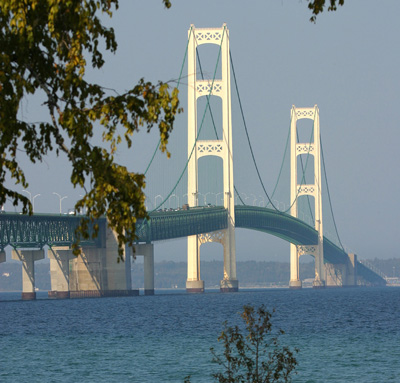
Rising 552 feet (that's 55 stories!) above the Straits of Mackinac, where Lakes Michigan and Huron meet, is the world-famous Mackinac Bridge. Also known as the "Mighty Mac," this engineering marvel is 5 miles long anchor block to anchor block. It held the record as the longest suspension bridge in the world for half a century!
Before the Mackinac Bridge was constructed, travelers between Michigan's upper and lower peninsulas had to cross the Straits via an hour-long ferry ride. On busy weekends, like the start of hunting season or the Fourth of July holiday, carloads of anxious travelers would wait in line as long as 24 hours to catch a ferry.

Although the bridge was envisioned way back in the late 1800s, Sen. Prentiss M. Brown, Sr., the "Father of the Mackinac Bridge," was the key figure in the bridge construction project. Governor-elect G. Mennen (Soapie) Williams was another strong advocate for the bridge and helped to create the Mackinac Bridge Authority in 1950. The bridge designer was Dr. David B. Steinman and primary construction firms were Merrit-Chapman & Scott and the American Bridge Division of U.S. Steel.
Today, the Mackinac Bridge is hailed as one of the most outstanding engineering achievements of the century and leaves people wondering how Michigan ever got along without it! The 100 millionth crossing of the bridge happened on June 25, 1998.
The construction period: 1954-1957
Because the bridge was in a remote area, financing the project was slow and difficult. The total cost of the project was upwards of $100 million (originally estimated at $70 million).
Construction began in 1954 and during the 42 months that followed hundreds of men worked on the various phases of the bridge construction. The first step was to sink the large, double-walled cylinders that form the bases of the two main tower piers. These cylinders are called caissons (cay-sans). The caissons had to be sunk down into the bedrock on the lake floor, a great challenge for the divers involved. When the foundation pillars were finished, the iron workers were brought in to string the massive cabling network! More than 500 workers were housed in St. Ignace, Mich., during this construction period.
A "catwalk" made of cyclone fence enabled the workers to navigate between the bridge towers, high above the lake below. When finished, the cables were close to 25 inches in diameter. Each cable consists of 340 wires banded into a single strand; 37 strands are then assembled into a single cable. To complete the job and add extra strength, a covering is spun around each finished cable. More than 42,000 miles of wire were used in the two main bridge cables!
The last step was to construct the road surface. The inner lane on the middle span of the bridge includes an open grid riding surface. This was installed to allow wind forces to move through the bridge.
Old Mackinac Point Lighthouse

Founded in 1889, Old Mackinac Point Light Station was in operation from 1890 until 1957. The lighthouse is located within Michilimackinac State Park, just a few hundred feet east of the Mackinac Bridge and the Colonial Michilimackinac Visitors Center.
The lighthouse is currently open to the public. Continuing restoration of the light station to its 1910 appearance includes the exteriors and interiors of the buildings as well as the grounds. The lighthouse contains the restored keeper's quarters and hands-on exhibits throughout the fully-accessible first floor. Costumed interpreters provide regular tours, including guiding groups up the lighthouse tower.
Access to the historic site is through the station's 1907 Fog Signal building which serves as the admissions point and contains the Lighthouse Museum Store. A wide variety of lighthouse and maritime books and keepsakes are available for purchase. All admission and store sale proceeds are used in the ongoing restoration.
Colonial Michilimackinac
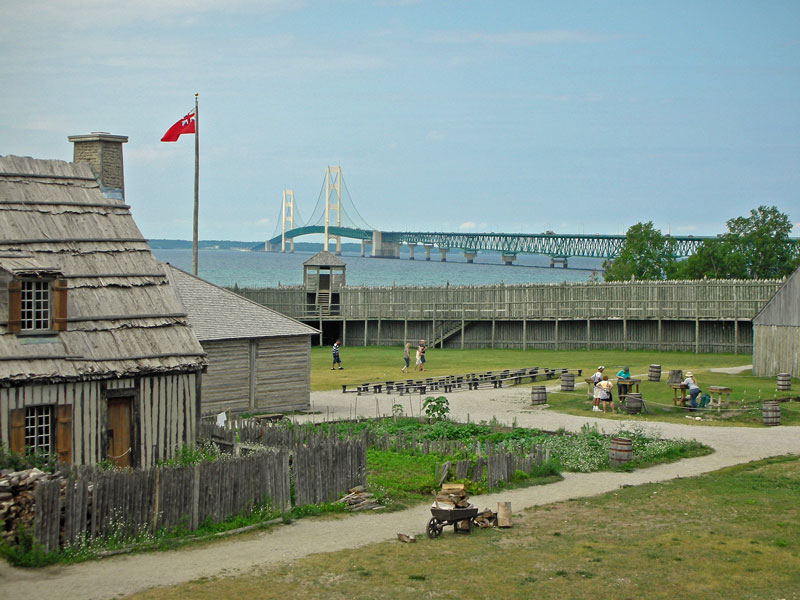
Colonial Michilimackinac, often refered to as Fort Michilimackinac, is a reconstructed 1715 French fur-trading village and military outpost that was later occupied by British military and traders.
In 1761 the French relinquished Fort Michilimackinac to the British who had assumed control of Canada as a result of their victory in the French and Indian War. Under the British, the fort continued to serve as a major fur trade facility. The Ottawa and Chippewa in the Straits area, however, found British policies harsh compared to those of the French and they resented the British takeover. In 1763 as part of Pontiac's Rebellion, a group of Chippewa staged a ball game outside the stockade to create a diversion and gain entrance to the post and then attacked and killed most of the British occupants. The use of Fort Michilimackinac came to an end in 1781 when the British abandoned the post and moved to Fort Mackinac on Mackinac Island.
Today, it features re-enactments from British 1770s occupation and the American Revolution era. A National Historic Landmark, Colonial Michilimackinac is accredited by the American Association of Museums.
Historic Mill Creek
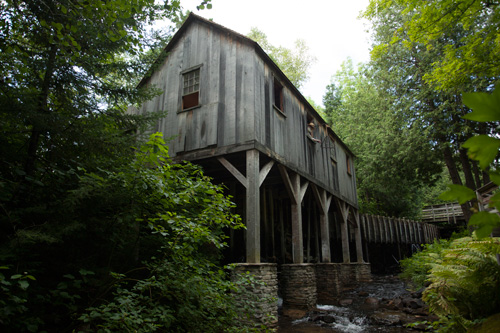
As the Straits of Mackinac's first industrial complex, Mill Creek provided sawn lumber for the settlement of Mackinac Island in the 1790s.
Today at the 625-acre state park, you can enjoy an exciting blend of living history demonstrations and nature interpretation along the many scenic trails. Feel the 1790s sawmill rumble as water power drives the blade. Try your hand on the pit saw. Naturalists explain the local flora and fauna.
Downtown Shopping District
Downtown Mackinaw City is known for its Shopping District filled with numerous shops and eateries. You will be sure to find that special souvenier that you are looking for in Mackinac Bay Trading Co., The Mackinaw Crossings, and the shops lining South Huron & Central Avenue.
The Dixie Saloon
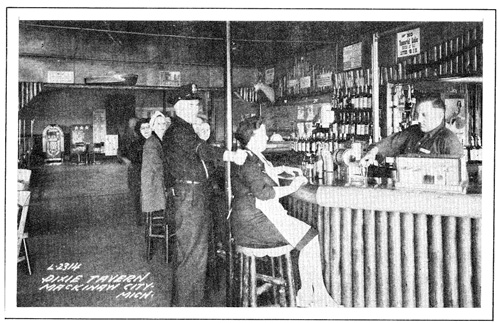

Since the near end of the 1800's, the Dixie Saloon has stood as a landmark of the end of the Old Dixie Highway. The Old Dixie Highway ran the complete length of the United States Eastern coastline, stretching from Florida all the way up to Mackinaw City, eventually being replaced by Interstate 75. Travelers started the tradition of celebrating a journey's end with good friends and good drink within the walls of the Dixie Saloon, then known as the Dixie Tavern.
Today the Dixie Saloon continues that tradition of good times and good hospitality inside the newly renovated building. The new all cedar structure is two stories tall, with an inviting open-air interior that spans both stories. Large cedar columns rise from floor to ceiling and the second level offers additional seating and a top-side view of the level below. Those stopping by can enjoy the beauty that the Straits of Mackinac and the Mackinac Bridge have to offer year round through the many windows that encircle the saloon.
The Dixie Saloon is a must see attraction located at the corner of Huron and Central in Mackinaw City, right across from Shepler's Mackinac Island Ferry Docks. Sitting in the center of the downtown Mackinaw City shopping district, the Dixie Saloon has become the heart of Mackinaw City's night life offering a menu of Mackinaw's best steaks, ribs, and burgers as well as the largest bar in Mackinaw City. The Dixie has live entertainment on weekends year round, and Karaoke during the week.
Mackinac Bay Trading Co.
The current location of Mackinac Bay Trading Co. has served many purposes over the past century. In the early 1900's Mackinaw City, though a small town, was bustling with activity due to the railroad industry. Nine passenger trains as well as freight trains would arrive and depart daily. Around 1926 the property was owned by the Michigan Central Railroad, the first of the three railroads that formed the Mackinac Transportation Company along with the Pennsylvania Railroad Company and Duluth South Shore & Atlantic Railroad Company.
The Michigan Central Railroad leased a small section of the land to Harry Teysen, who opened a small food stand for travelers to the area. Around 1930, Teysen expanded his stand into a full service restaurant.
Around 1945, the Michigan Central Railroad converted the location into the Greyhound Bus House and Teysen chose to move his operation a few blocks to the south. The current location of Nonna Lisa's Italian Restaurant was originally the garage for the bus station and is the only original part of the building. It features Mackinaw's only wood-fired pizza oven, the largest collection of animal furs, and the north's largest stone fireplace and waterfall. Several retailers have occupied the location after that time including Traverse Bay Woolen Company, known for rustic handicrafts and the warm, northern atmosphere of the store.
Mackinac Bay Trading Co. keeps the rustic northern tradition alive today with numerous shops including Woodland Creek Furniture, Devon's Fudge, Mackinac Bay Build Your Bear, & Nonna Lisa's Italian Restaurant, which has a custom made bar of redwood and juniper that has become quite an attraction.
Conkling Heritage Park
Named after Edgar Conkling, founder of Mackinaw City, this park offers free concerts during the summer at the band shell and is one of the best spots to enjoy Independence Day fireworks. With a beautiful view of Lake Huron and Mackinac Island, the park is located adjacent to the Best Western Dockside and across the street from Mackinac Bay Trading Company.
Alexander Henry Park
Alexander Henry Park is located near Colonial Michilimackinac and offers wonderful views of vibrant blue waters of the Straits of Mackinac, the Mackinac Bridge and Mackinac Island. The park features handicapped accessible lakefront walkway and is adjacent to Old Mackinac Point Lighthouse. Directly across the street from the Super 8 Bridgeview.
Mackinac Island

Mackinac Island visitors arriving by ferry boat will land in historic Haldimand Bay, named in honor of General Fredrick Haldimand who was governor of Canada in 1780 during the American Revolution when Fort Mackinac was built.
Getting Around Mackinac Island
One of the best things that ever happened to Mackinac Island was the automobile ban beginning in 1898. The absence of cars and the resulting benefits, exhaust free air, quaint and narrow village lanes, no auto noise and picturesque horse-drawn carriages, have created a unique, charming and historic ambience.

Most visitors travel by foot power, either by walking or peddling. Many of the islands popular sites, including Fort Mackinac, the village business district, The Grand Hotel, cottages on the East and West Bluffs, and Arch Rock are less than a mile from the Visitors Center.
Mackinac Island is a bike rider's paradise, especially the road around the island. Eight miles in circumference, Lake Shore Boulevard (M-185) is the only state highway where cars are banned! This picturesque route takes riders past Arch Rock, British Landing, and Brown's Brook and provides spectacular views of the shimmering blue waters of the Straits of Mackinac.
Horse-drawn carriage tours of the island's scenic and historic sites are very popular. Other visitors, who prefer a more "hands on" approach, can go horseback riding or rent a drive-it-yourself carriage. Horse drawn taxis are also available for transportation.
A Brief History of Mackinac Island
Mackinac's First People
Great Lakes American Indians were Mackinac Island's first summer visitors. These Woodland-period (1,000 B.C. to 1650 A.D.) people paddled to Mackinac Island every summer to fish for trout, pike, sturgeon, herring, and whitefish. So plentiful were the fish at Mackinac that the native people called these waters "home of the fish".
Early European Settlement
European settlement in the Straits of Mackinac began in 1671 when Father Jacques Marquette established a mission to Huron Indians on Mackinac Island. A year later the mission was moved to the north side of the Straits of Mackinac and, around 1708, to the south shore near present day Mackinaw City. Here, French soldiers constructed Fort Michilimackinac, a strategic depot for the upper Great Lakes fur trade. Michilimackinac remained a French outpost until 1761 when British soldiers took control after their victory in the Seven Years War.
The Revolution at Mackinac
In 1779-1781, during the American Revolution, the British dismantled Michilimackinac and moved the garrison and fur trade community to Mackinac Island. Mackinac Island with its steep limestone bluffs offered a perfect location for the new fort. The fort and island became United States territory as a result of the American victory in the Revolution.
War at Mackinac, 1812-1815
War broke out between the United States and Great Britian in the summer of 1812. Under the cover of darkness British soldiers landed on the north shore of Mackinac Island, dragged their cannon to the high ground behind the fort, took positions in the woods and prepared to attack. American soldiers, completely surprised, quickly surrendered without a fight. Two years later, American soldiers tried to recapture Fort Mackinac but were badly defeated in the only battle ever fought on Mackinac Island.
The Flourishing Fur Trade
By December 1814, the war was over. American peace negotiators accomplished what their troops failed to do, as the peace treaty restored the island and Fort Mackinac to the United States. On Mackinac Island's Market Street, furs were counted, sorted and baled for shipment to the east coast and Europe. Millions of dollars worth of furs passed through Mackinac Island in the 1820's.
Home of the Fish
Commercial fishing replaced fur trading as Mackinac Island's primary industry in the 1830s. The region's waters teemed with a rich bounty of whitefish, lake trout, pickerel and cisco.
A Place of Resort
After the civil war, and expanding railroad system and improved passenger steamships linked urban travelers with the country's rustic vacation spots. Mackinac Island, with its historic charm, scenic beauty and healthy environment, was a natural summer resort. In response to the island's growing popularity, the federal government created Mackinac National Park in 1875. This was America's second national park, established just three years after Yellowstone.
Oh, Fudge!
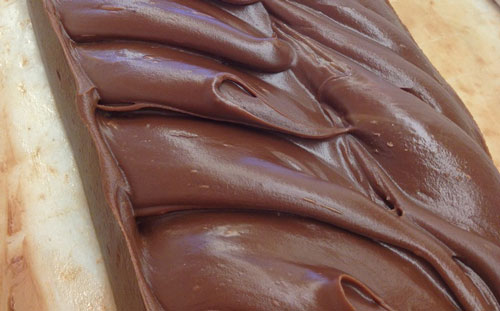
Two years after the Grand was built, Henry Murdick opened the island's first "Candy Kitchen". By the 1920s fudge became the number one sweet souvenir of Mackinaw City and Mackinac Island. A popular favorite is Devon's Fudge located in Mackinac Bay Trading Company in Mackinaw City.
In 1945, after 115 years of service, the United States Army removed the soldiers from Fort Mackinac. The Federal Government transferred the fort and national park to the state, and Michigan's first state park and the Mackinac Island State Park Commission were created.
Mackinac Island Attractions
Fort Mackinac
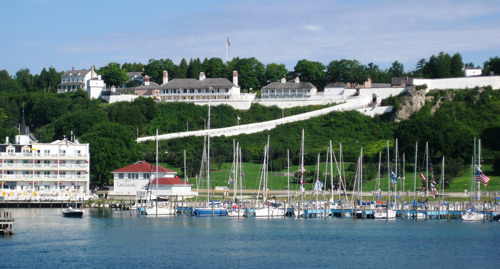

Fort Mackinac served as a military outpost for British, and later, American soldiers from 1780 to 1895. The role of the military on Mackinac Island changed dramatically during the fort's 115 year history. In the early years Fort Mackinac was a crucial Great Lakes border post and its soldiers helped protect the lucrative fur trade and maintain alliances with neighboring Indian tribes. By the late 19th century the post had outlived its military importance but gained new significance when Mackinac National Park was established in 1875.
You can inspect the Fort buildings in any order that you desire. Every building in Fort Mackinac is original, built by the army and used by soldiers over 100 years ago.
The largest building at Fort Mackinac, the Soldier's Barracks (1859) was home to the enlisted men. The Post Commissary (1878) was the warehouse for food supplies. The Post Headquarters (1854) was the administrative center of Fort Mackinac. The Quartermaster's Storehouse (1867) housed supplies, equipment and uniforms used by the soldiers. The Post Bathhouse was one of the last buildings constructed at Fort Mackinac. Constructed in 1885 during a "hygiene fever", the building featured six cast iron tubs and hot and cold running water. The Post Guardhouse (1828) was headquarters for the soldiers assigned to twenty-four hour guard duty and served as a jail for prisoners convicted of crimes or awaiting trial. The Wood Quarters (1816) was used as a soldiers' barracks, officers' quarters, temporary hospital, laundress quarters and storehouse. The Officers' Stone Quarters (1780) is one of the oldest buildings in Michigan, and was often the home of the post commandant. The Post Hospital (1828) is Michigan's oldest hospital building. The Officers' Hill Quarters (1835) was home for two officers and their families. The Post Schoolhouse (1879) provided educational opportunities for soldiers and their children.
McGulpin House
On the east end of Market Street, this is one of this island's oldest structures, dating back to 1780 or earlier.
Dr. Beaumont Museum / American Fur Company Store
This building was the American Fur Company Store selling a variety of general merchandise. Exhibits inside explain a fateful accident that happened at the scene. The Fort Mackinac surgeon's experiments on the patient led to the discovery of enzymes.
Robert Stuart House
Further down market street, past the U.S. Post Office is the Robert Stuart House (1817). Robert Stuart served as the American Fur Company's resident manager and used the house as his home and office.
American Fur Company Warehouse
The American Fur Company Warehouse (1810) is where a small army of clerks processed fur pelts such as mink, muskrat, otter and especially beaver.
Missionary Bark Chapel
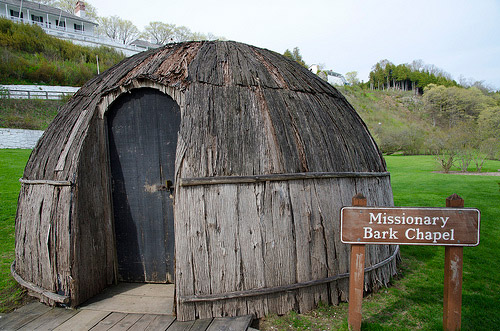
Located in Marquette Park. This park is named in honor of Father Jacques Marquette who brought a band of Huron Indians to Mackinac Island in 1671. The Huron had been seeking a home ever since they were driven out of southern Ontario by Iroquois warriors in the 1650s.
Trinity Episcopal Church
This house of worship opposite the bark chapel was built in 1882.
Indian Dormitory
When Great Lakes Indians traded their rights to Michigan lands for annual payments in the 1836 Treaty of Washington, the government agreed to erect a building on Mackinac Island where they could live when they visited the government agent. Two years later the Indian Dormitory was constructed to fulfill this purpose.
Ste. Anne's Church
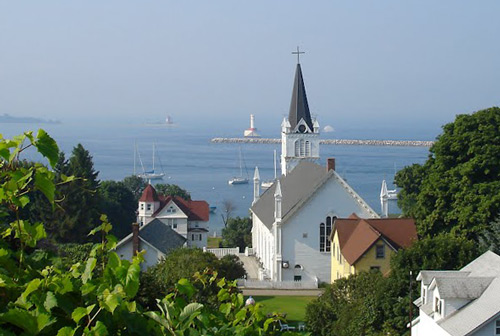
Ste. Anne's Roman Catholic Church traces its roots to Marquette's 1671 mission on Mackinac Island. This current structure was built in 1874.
Stonecliffe
This turn of the century mansion, once the largest summer cottage on the island, is an excellent example of Tudor Revival architecture.
Mission Church
Built in 1829, it is the oldest surviving church building in Michigan.
Skull Cave
Alexander Henry, befriended by Ojibwa chief Wawatam, was hidden in this cave when a successful Indian uprising took place at Michilimackinac on the mainland in 1763. He had spent a very uncomfortable night sleeping on a bed of human skulls. The local tribe used the cave to bury its dead.
Arch Rock
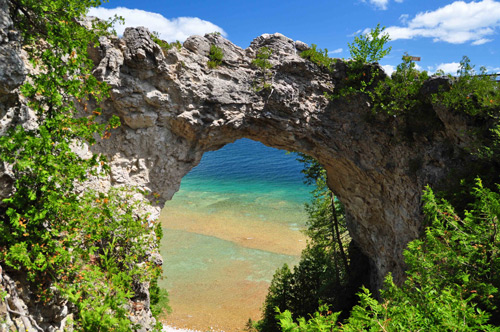
Rising 146 feet above the water, Arch Rock is a natural curiosity which spans fifty feet at its widest point. Geologists explain that the arch was formed over thousands of years of wind and water eroding soft rock below, leaving only the hard breccia rock which forms the arch.
Sugar Loaf
Another famous natural formation, this dramatic breccia mass rises 75 feet above the ground and is the largest of Mackinac Island's limestone stacks.
Governor's Summer Residence
The Governor's Summer Residence was originally constructed in 1902 as a private summer cottage. The residence is open to the public from 9:30 a.m. - 11:30 a.m. on Wednesdays during the summer.
Hubbard's Annex
This is a community of summer cottages developed in the 1880s at the same time homes along the West Bluff were built.
Scout Barracks
Built in 1934 as a Civilian Conservation Corp. project, the Scout barracks houses Boy or Girl Scouts troops from all over Michigan.
The Battlefield
Americans regretted the loss of Fort Mackinac to the British in 1812. Led by Colonel George Croghan and Major Andrew Hunter Holmes, American invaders came back in force two years later. They landed at British Landing and advanced to the edge of the woods at the north side of the present golf course. After an exchange of gunfire, it became obvious to the Americans that the British and their Indian allies were well entrenched and they retreated back to British Landing.




